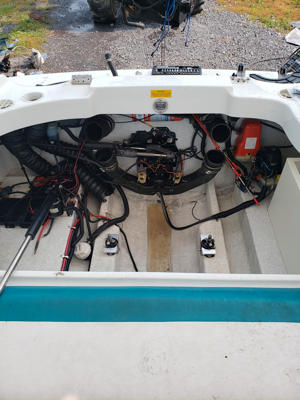Subject: Wet Wood (Engine Mounts)
Date: Thursday, September 18, 2020

I have a boat that has stripped motor mounts to due to wet rot getting where the bolts are. See engine mount on left in Pix.
I’m wondering if I remove bolts put your product in with the help of gravility, would it fill the hole and absorb into the wood below.
Maybe drill a couple holes. Let me know if you think your product may help me.
Once dried, can I drill into this and use a bolt/screw that is for wood on this. Would it hold?
Thanks,
Ron
Ron,
Engine mounts can be tricky for a few reasons. One is access. Which isn’t a problem for you. Another issue is making sure that a good enough repair is done. Depending on the rotation of the crank, one side is trying to push down, and one side is trying to pull up. It is the upward pulling side that is more critical, although you want to do a good repair on both sides, really.
By just pouring products down the existing hole, you are not likely to do a good enough job for a permanent, strong repair. The load needs to be able to spread out over a larger area that is strong. Otherwise the screw is likely to just pull out. Ideally, you want at least 6–12 inches of good, strong material surrounding the screw. This means drying out the wood, and making sure it is well soaked with the penetrating epoxy out to 6 inches to either side. Technically, this could be done just from the original hole. But it is very difficult. Which means either drilling holes down into the top, or cutting the top off completely. Cutting the top off might seem like more work, but really it isn’t.
The wetness of the wood is another consideration. Even if you were to dry out a 12 inch section of the stringer, treat it with penetrating epoxy, and re-glass the area, if the rest of stringer is left wet, it might rot. If the section around the engine mounts is repaired well, this future rot won’t affect the strength of the mount. But it is a consideration now. Since you are already there, with the engine out, you might want to make sure that the stringer is dried out as much a practical, to try and avoid future rot.
If it were me, I would drill staggered holes, every 6–8 inches, starting near the motor mounts, to assess the quality of the stringer. Really, there are a variety of conditions, from wet, with possible delamination, to rotted, to completely hollow. While you use the same products either way, the best way to do a repair would depend on exactly what is going on inside. Even if you later decided to cut open the top, some drill holes would not change things at all.
Once I had determined the extent and quality of the damage, I would either treat the stringer through the drill holes, or open things up for treatment or to replace the damaged section of wood. And how much of each product might be needed.
I hope this is helpful. Please let me know if you have further questions.
Doc